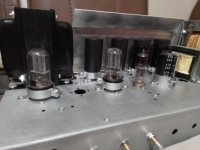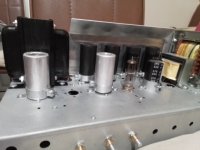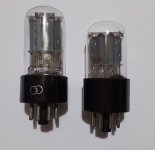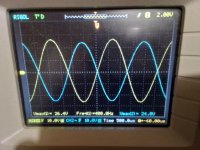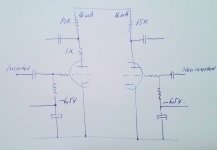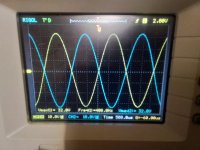15 dB of feedback isn’t a whole hell of a lot. You probably wont run into the “Williamson problems” until it gets well north of 20dB. FWIW, I got an enhanced Williamson very stable with a 1650W OPT. It was always stable, but did take some modification in the feedback at LF to get the settling time down. I tried almost the same gain staging (EL34 vs 6550) with smaller OPTs and there was no way of getting it stable. Ended up going to a Mullard topology, with even higher gain output tubes (10JA5) with 5 more dB of NFB. Not a single LF overshoot in the whole development.No, it is not a such thing. I used a generic Hammond 2k Raa to drive 6 x kt66 triode strapped. Excellent stable from open loop to 15db nfb applied . I didn't bothered to inject more, it is already to tight with the speakers I have. Also didn't considered THD refinements, just looking to enjoy a hefty classic tube sound with enough power to shake some...Still a Williamson structure of circuit, I squeezed a little bit more output with the transformer I have ending with 60W rms, meant 20w per pair at 450V supply.
Perhaps worth assessing your entire audio setup to see what mechanical adjustments can help, starting with the valve itself and its socket, through to how the amp is mounted.Still, I found 6sn7 a very rattle structure (not quite microphonic but mechanical disease), at least all the tubes I have. How do you negotiate with such of things please ? Thanks.
Some insight in link : https://dalmura.com.au/static/Microphonics in valves.pdf
Dave Gillespie's revision of the early Heathkit Williamson, the W-2, is worth going over if you haven't. It's a good primer on stabilizing the basic Williamson. He resolved the low-frequency "breathing" and recovery issue by greatly enlarging the first pair of coupling caps to essentially eliminate that pole, and reducing the value of the second pair. This is the configuration I use and it works very well. I've even restored a pair of W-2s to his specifications and it's a far better amp than the original. ;-) When you get into higher-powered Williamsons, then Bench Baron makes some excellent points. Hafler's 60 watt, fixed-bias design uses low-frequency stabilizing networks across the driver-stage output caps.
http://www.audiokarma.org/forums/index.php?threads/regilding-the-gilded-lily-heaths-w-2m.767851/

http://www.audiokarma.org/forums/index.php?threads/regilding-the-gilded-lily-heaths-w-2m.767851/
I think it depends on the 6SN7. I use NOS GE 6SN7GTB and rarely come across a microphonic one. Same with Sylvania 6SN7WGT. Are those Russian 6SN7s in the photo? You might have to do some selecting.
Also, if you're not using much, or any, feedback, the gain is really tremendous and the amp is going to be far more sensitive to any microphonics in the tubes.
You ain´t heard nothin´yet...... One can do worse by going over to some tubes designated for early TV and note the microphony differences when compared to audio types. Video line pentodes can be particulary noisy and sensitive to knocks as manufacturers didn´t bother about high distortion nor microphony.. The only way around this is to buy several (50 off cheap at car boot sales or ebay) and test individually for the best, strap them as triodes and hope for the best, or fit acoustic type screening cans.. OMO, the 6SN7 as an medium mu tube, scores pretty good with lowish noise.
Of 250 off 12BY7A´s I found only 10% matched reasonably over characteristics, NOT including distortion ! Sylvania was the worst followed by RCA; best consistency was ECGPhilips. Out of those 10% a mere handful could be assigned as true matched in all and those were from ECG Philips.
BB
Of 250 off 12BY7A´s I found only 10% matched reasonably over characteristics, NOT including distortion ! Sylvania was the worst followed by RCA; best consistency was ECGPhilips. Out of those 10% a mere handful could be assigned as true matched in all and those were from ECG Philips.
BB
The tubes are not microfonic in a sense that mean sensitive to EM fields . More, I shielded it with tube cages made from old used caps to be sure never happen. The mechanical structure is a compromise. I have few couples of these and are more or less the same. I put a picture: left 6sn7, 6sl7 on the right ( okay there are Russian equivalents) Despite the highest gain the 6sl7 get a lower rattle noise than 6sn7 in the left.
Attachments
Last edited:
Ok, so perhaps read the linked doc in post #22 and think through your options to mechanically isolate (a) the table from the floor, and (b) the amp from the table. Isolating the valve from the amp may be more onerous for you.
Is the valve 'rigidly' connected to its valve socket and the amp chassis?
Is the valve 'rigidly' connected to its valve socket and the amp chassis?
I had the same problem with an amplifier using only directly heated tubes (2x 3d6, 801A). Problem was solved by taking out the screws and shoving a few layers of an old handkerchief between sockets and the chassis. The only "problem" is that when changing tubes you have to hiold the socket with your free hand. The circuitry will keep the tube in place so you don't have to worry about that.
How to fix AC balance at drivers output please ? The DC offset is pretty good - less than 100mV at plates but AC swing shows more than 2Vpk difference. The signal at cathodyne output is also perfect balanced. Is just a matter of gain diference between two sections of driver I used. How can be fixed to get same balanced AC signal at power inputs please? -My drivers do not work in common mode, there are independent, individual biased- Thanks.
Attachments
Last edited:
Original Williamson used a pot in the driver B+ connection. The aim is to minimise harmonic distortion at speaker output, so that all imbalances along the signal path are accounted for. Best to do that with a spectrum analyser software and with feedback disconnected.
I thought those adjustment was used for dc offset as time the tubes shared the same common cathode resistor...but yes I may use it to optimize the ac swing aso. Is exactly what ejp suggest. My drivers are independent grid biased there are easy to adjust modifying the dc currents through.Thanks
- Home
- Amplifiers
- Tubes / Valves
- Williamson first stage question
